Get to Know Nohgaku

Introduction to Nohgaku
Nohgaku described simply
Nohgaku is a term that collectively refers to Noh theater and Kyogen theater.
Consisting of songs and dances, Noh is a Japanese style musical theater. Another key feature of Noh is that masks are used in all performances.
Kyogen is a traditional comedic theater based on dialogue, something close to today’s skits and performances by comedy duos.
While the characters of Noh are unworldly beings or invisible beings like gods, goblins, ghosts, and flower/tree spirits, Kyogen plays humorously depict common, ordinary people.


The history of Noh and Kyogen
Noh is said to have been perfected by Kan’ami and his son Zeami in the Muromachi Period (1336 – 1573). However, its roots can be traced back to the Nara Period (710 – 794). Initially, a form of comprehensive entertainment called Sangaku was introduced from China. This was combined with Japan’s various performing arts and developed into a form of entertainment called Sarugaku. Consisting of a wide range of entertainment from mimicry, acrobatics, short plays to singing and dancing, Sarugaku shows were generally meant to make the audience laugh. It is said that this comical quality of Sarugaku has been carried on by Kyogen to the present day.
On the other hand, Noh developed as a form of theater (drama and drama with singing & dancing) by incorporating poems and literary works into Sarugaku shows. Noh was further sophisticated in the Muromachi Period when it became to be presented in front of first-class cultured people like Ashikaga Yoshimitsu, a shogun of the Muromachi Period who became an enthusiastic fan of Kan’ami and his son Zeami.
During the Momoyama Period (the late 16th century), many feudal lords and warlords including Toyotomi Hideyoshi, who completed the 16th-century unification of Japan, began to enjoy practicing and performing Noh plays themselves.
In the Edo Period (1603 – 1868), Noh was designated as one of the official performing arts to be presented at ceremonies of the Tokugawa shogunate. By this, samurai warriors were required to be well versed in Noh. Since then, Noh plays were performed at various events and ceremonies of the shogunate and Noh actors were employed as servants of the shogunate or a local domain. Although a gap emerged between the commoners and Noh after it was designated as an official performing art, people continued to practice Noh chants actively and Noh lessons were given at schools for commoners called terakoya.
The Nohgaku world faced a crisis when it lost the support of the Tokugawa shogunate following the Meiji Restoration in the late 19th century. However, it was revitalized by the efforts of Iwakura Tomomi, a politician who realized the importance of protecting the arts after visiting a number of countries and established a Nohgaku theater named Nohgakusha.
Counting from the time of Kan’ami and Zeami, Nohgaku has been passed down through generations uninterruptedly for at least 650 years. Said to be the oldest surviving form of theater in the world, Nohgaku was inscribed in 2008 on UNESCO’s Representative List of the Intangible Cultural Heritage of Humanity.
The connection between Noh and Kyogen
This perfect balance between Noh and Kyogen is perhaps one of the reasons why Nohgaku has been loved for centuries.

The worlds depicted by Nohgaku

Kyogen portrays everyday life. The human essence is humorously depicted through characters that are ostentatious, clumsy, or mischievous. You will discover that those characters of plays that were written centuries ago are no different from us. These plays tell us that human nature is consistent regardless of time, another wonderful feature of Nohgaku.